sensor NISSAN TITAN 2021 Owner´s Manual
[x] Cancel search | Manufacturer: NISSAN, Model Year: 2021, Model line: TITAN, Model: NISSAN TITAN 2021Pages: 638, PDF Size: 4.31 MB
Page 12 of 638

1. Seat belt with pretensioner(s) (rear out-board seats) (if so equipped) (P. 1-16)
2. Roof-mounted curtain side-impact and
rollover supplemental air bag (P. 1-53) 3. Head restraints/headrests (P. 1-15)
4. Front seat belts with pretensioner(s)
and shoulder height adjuster (P. 1-16,
1-53) 5. Supplemental air bags (P. 1-53)
6. Occupant classification sensors (weight
sensors) (if so equipped) (P. 1-53)
7. Front seats (P. 1-2)
8. Front seat-mounted side-impact
supplemental air bag (P. 1-53)
9. Rear seats (if so equipped) (P. 1-16)
10. LATCH (Lower Anchors and Tethers for
CHildren) system (if so equipped)
(P. 1-28)
11. Top tether strap anchor (if so equipped)
(P. 1-28)
Refer to the page number indicated in
parentheses for operating details.
NOTE:
Crew Cab model shown, King Cab® model
similar.
LII2479
AIR BAGS, SEAT BELTS AND CHILD
RESTRAINTS
0-2Illustrated table of contents
Page 13 of 638
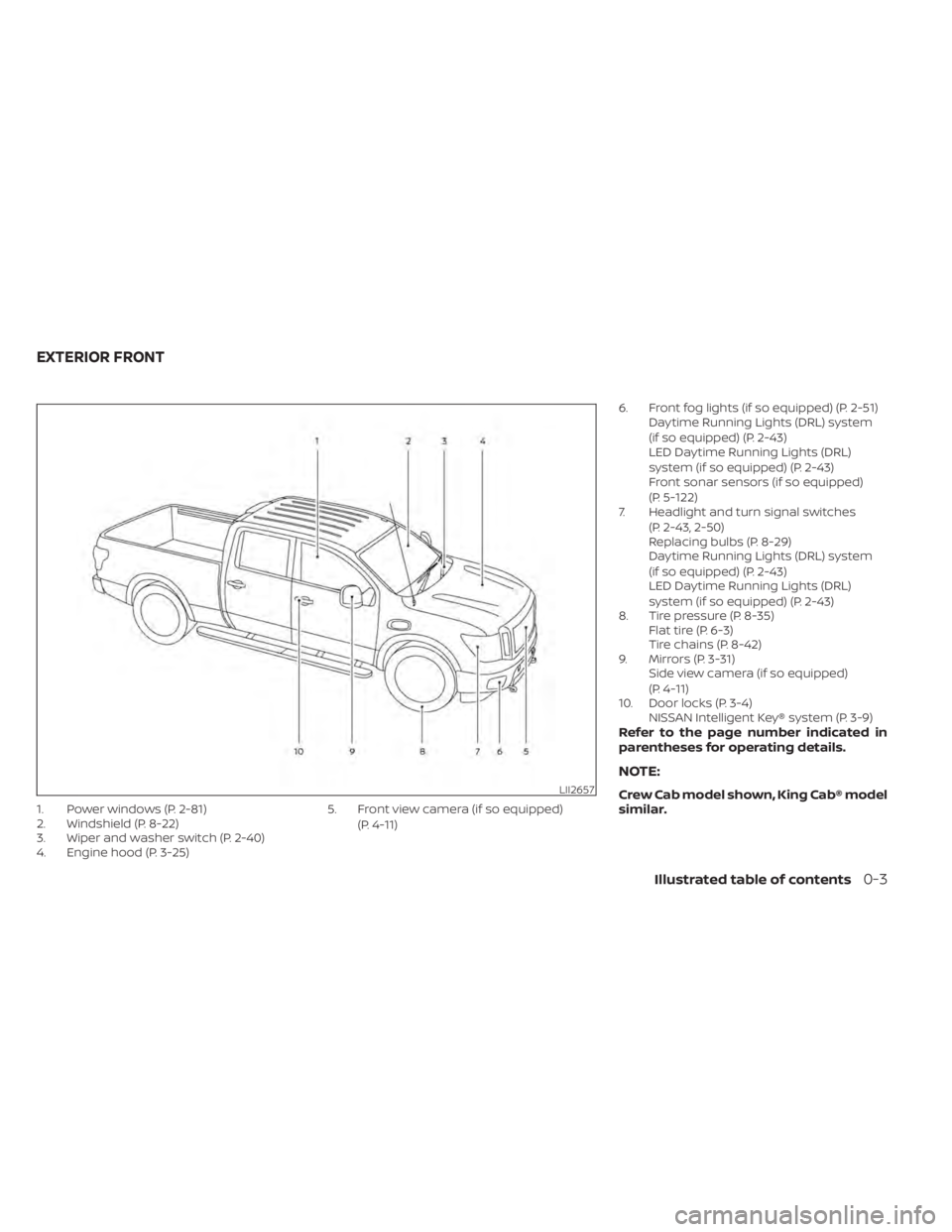
1. Power windows (P. 2-81)
2. Windshield (P. 8-22)
3. Wiper and washer switch (P. 2-40)
4. Engine hood (P. 3-25)5. Front view camera (if so equipped)
(P. 4-11) 6. Front fog lights (if so equipped) (P. 2-51)
Daytime Running Lights (DRL) system
(if so equipped) (P. 2-43)
LED Daytime Running Lights (DRL)
system (if so equipped) (P. 2-43)
Front sonar sensors (if so equipped)
(P. 5-122)
7. Headlight and turn signal switches
(P. 2-43, 2-50)
Replacing bulbs (P. 8-29)
Daytime Running Lights (DRL) system
(if so equipped) (P. 2-43)
LED Daytime Running Lights (DRL)
system (if so equipped) (P. 2-43)
8. Tire pressure (P. 8-35) Flat tire (P. 6-3)
Tire chains (P. 8-42)
9. Mirrors (P. 3-31) Side view camera (if so equipped)
(P. 4-11)
10. Door locks (P. 3-4) NISSAN Intelligent Key® system (P. 3-9)
Refer to the page number indicated in
parentheses for operating details.
NOTE:
Crew Cab model shown, King Cab® model
similar.LII2657
EXTERIOR FRONT
Illustrated table of contents0-3
Page 14 of 638
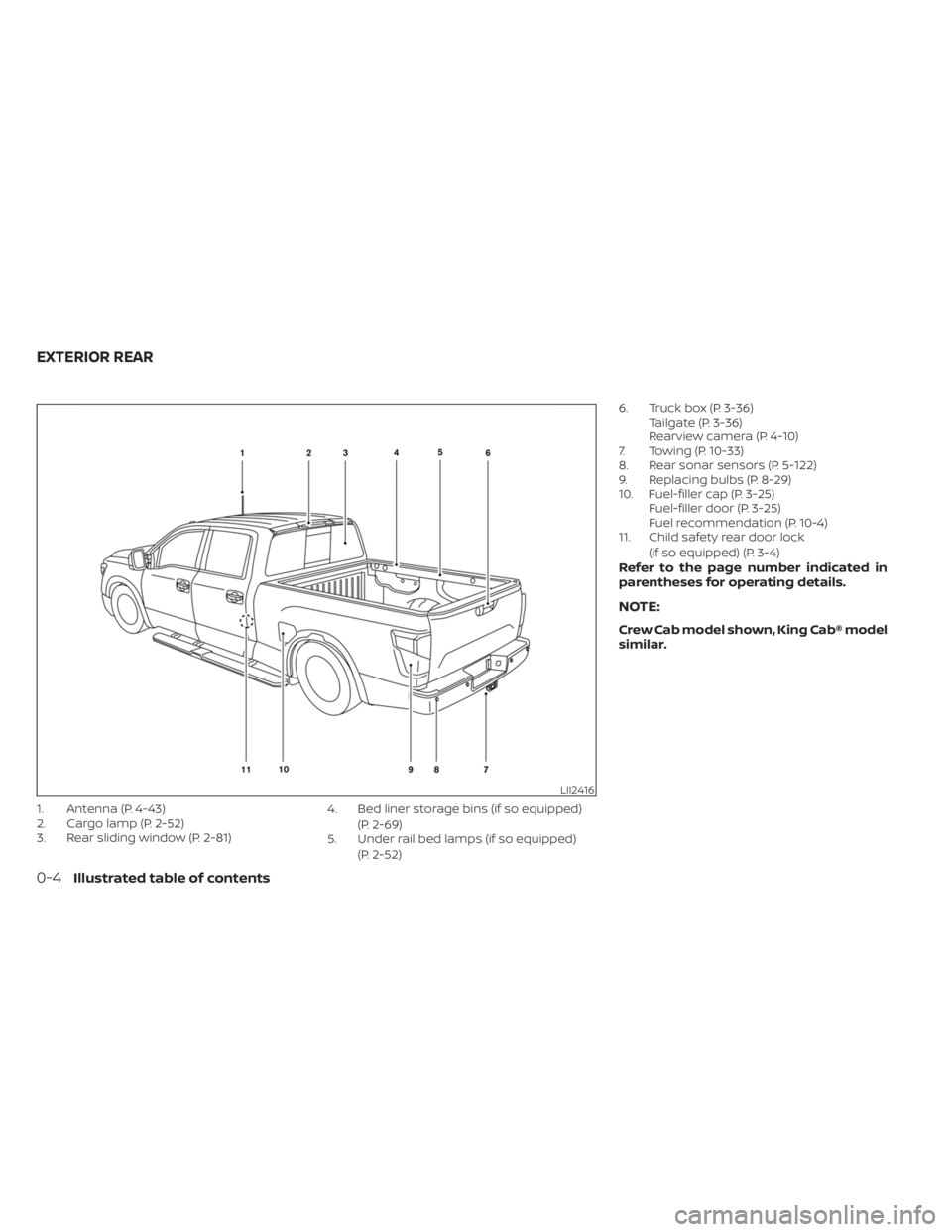
1. Antenna (P. 4-43)
2. Cargo lamp (P. 2-52)
3. Rear sliding window (P. 2-81)4. Bed liner storage bins (if so equipped)
(P. 2-69)
5. Under rail bed lamps (if so equipped)
(P. 2-52) 6. Truck box (P. 3-36)
Tailgate (P. 3-36)
Rearview camera (P. 4-10)
7. Towing (P. 10-33)
8. Rear sonar sensors (P. 5-122)
9. Replacing bulbs (P. 8-29)
10. Fuel-filler cap (P. 3-25) Fuel-filler door (P. 3-25)
Fuel recommendation (P. 10-4)
11. Child safety rear door lock
(if so equipped) (P. 3-4)
Refer to the page number indicated in
parentheses for operating details.
NOTE:
Crew Cab model shown, King Cab® model
similar.
LII2416
EXTERIOR REAR
0-4Illustrated table of contents
Page 77 of 638
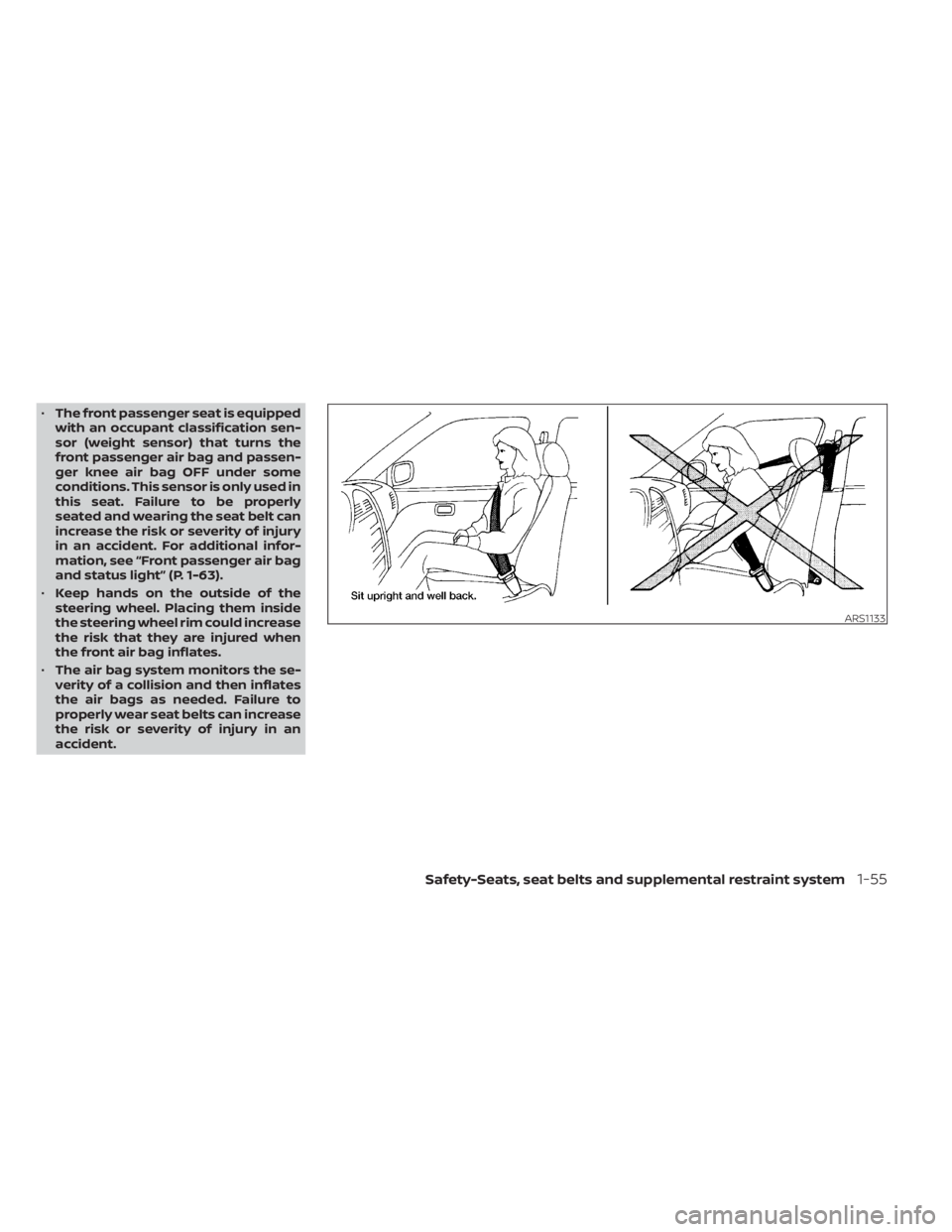
•The front passenger seat is equipped
with an occupant classification sen-
sor (weight sensor) that turns the
front passenger air bag and passen-
ger knee air bag OFF under some
conditions. This sensor is only used in
this seat. Failure to be properly
seated and wearing the seat belt can
increase the risk or severity of injury
in an accident. For additional infor-
mation, see “Front passenger air bag
and status light” (P. 1-63).
• Keep hands on the outside of the
steering wheel. Placing them inside
the steering wheel rim could increase
the risk that they are injured when
the front air bag inflates.
• The air bag system monitors the se-
verity of a collision and then inflates
the air bags as needed. Failure to
properly wear seat belts can increase
the risk or severity of injury in an
accident.
ARS1133
Safety-Seats, seat belts and supplemental restraint system1-55
Page 82 of 638
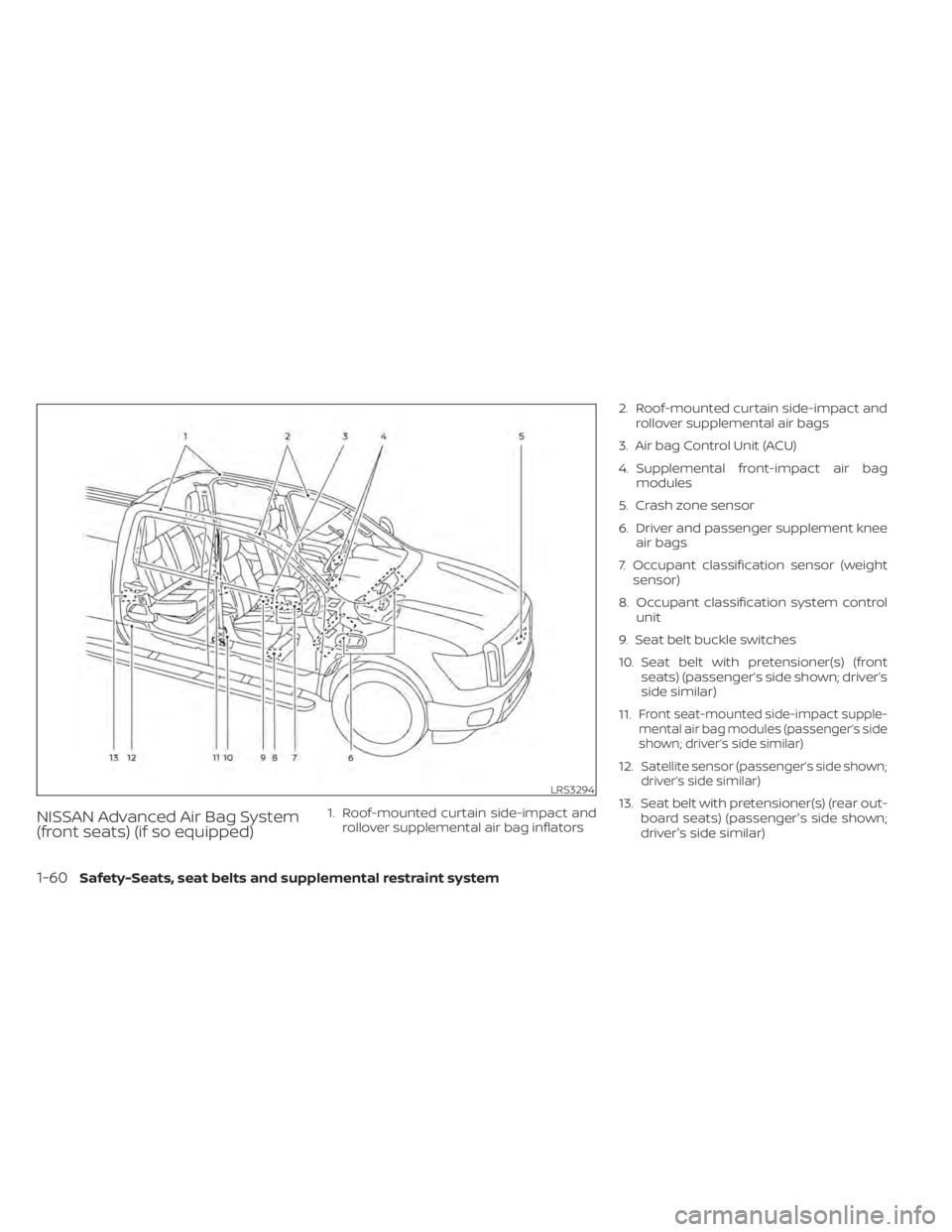
NISSAN Advanced Air Bag System
(front seats) (if so equipped)1. Roof-mounted curtain side-impact androllover supplemental air bag inflators 2. Roof-mounted curtain side-impact and
rollover supplemental air bags
3. Air bag Control Unit (ACU)
4. Supplemental front-impact air bag modules
5. Crash zone sensor
6. Driver and passenger supplement knee air bags
7. Occupant classification sensor (weight sensor)
8. Occupant classification system control unit
9. Seat belt buckle switches
10. Seat belt with pretensioner(s) (front seats) (passenger’s side shown; driver’s
side similar)
11.
Front seat-mounted side-impact supple-
mental air bag modules (passenger’s side
shown; driver’s side similar)
12.Satellite sensor (passenger’s side shown;
driver’s side similar)
13. Seat belt with pretensioner(s) (rear out- board seats) (passenger's side shown;
driver's side similar)LRS3294
1-60Safety-Seats, seat belts and supplemental restraint system
Page 83 of 638

WARNING
To ensure proper operation of the pas-
senger’s NISSAN Advanced Air Bag Sys-
tem, please observe the following
items.
• Do not allow a passenger in the rear
bench seats to push or pull on the
seatback pocket.
• Do not place heavy loads heavier
than 2.2 lbs. (1 kg) on the seatback,
head restraint or in the seatback
pocket.
• Do not store luggage behind the seat
that can press into the seatback.
• Do not position the front passenger
seat so it contacts the rear bench
seats. If the front seat does contact
the rear bench seats, the air bag sys-
tem may determine a sensor mal-
function has occurred and the front
passenger air bag status light may
illuminate and the supplemental air
bag warning light may flash. •
If a forward-facing child restraint is
installed in the front passenger seat,
do not position the front passenger
seat so the child restraint contacts
the instrument panel. If the child re-
straint does contact the instrument
panel, the system may determine the
seat as occupied and the passenger
air bag and passenger knee air bag
may deploy in a collision. Also the
front passenger air bag status light
may not illuminate. For additional
information, see “Child restraints”
(P. 1-28).
• Confirm the operating condition with
the front passenger air bag status
light.
• If you notice that the front passenger
air bag status light is not operating
as described in this section, get the
occupant classification system
checked. It is recommended that you
take your vehicle to a NISSAN dealer
for this service.
• Until you have confirmed with a
dealer that your passenger seat oc-
cupant classification system is work-
ing properly, position the occupants
in the rear seating positions. This vehicle is equipped with the NISSAN
Advanced Air Bag System for the driver and
front passenger seats.
All of the informa-
tion, cautions and warnings in this
manual still apply and must be followed.
The driver supplemental front-impact air
bag is located in the center of the steering
wheel. The front passenger supplemental
front-impact air bag is mounted in the
dashboard above the glove box. The front
air bags are designed to inflate in higher
severity frontal collisions, although they
may inflate if the forces in another type of
collision are similar to those of a higher
severity frontal impact. They may not in-
flate in certain frontal collisions. Vehicle
damage (or lack of it) is not always an indi-
cation of proper front air bag system op-
eration.
The NISSAN Advanced Air Bag System
monitors information from the crash zone
sensor and the Air bag Control Unit (ACU).
Inflator operation is based on the severity
of a collision and seat belt usage for the
driver. For the front passenger, the occu-
pant classification sensor is also moni-
tored. Based upon the information from
the sensor, only one front air bag may in-
flate in a crash, depending on the crash
severity. Additionally, the front passenger
Safety-Seats, seat belts and supplemental restraint system1-61
Page 85 of 638
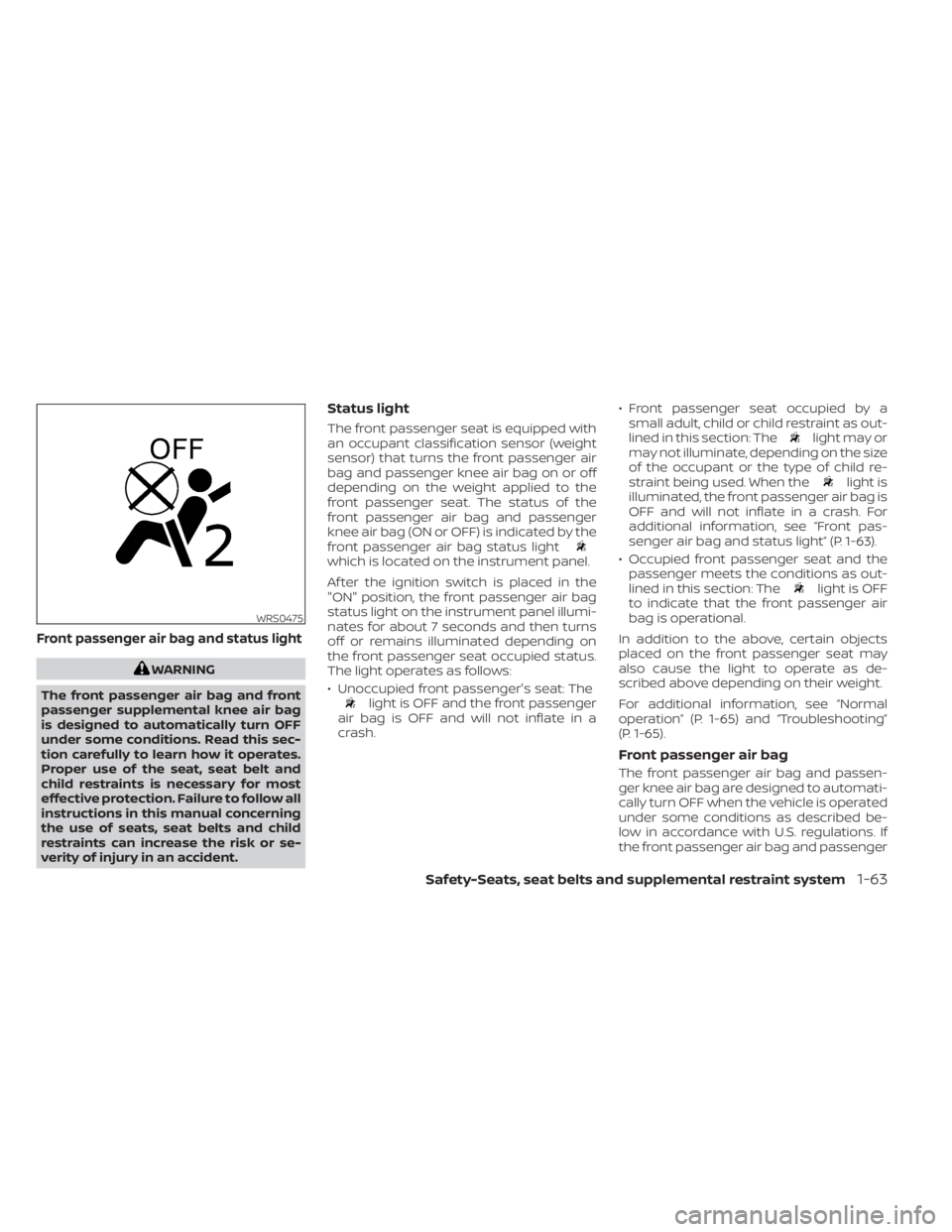
Front passenger air bag and status light
WARNING
The front passenger air bag and front
passenger supplemental knee air bag
is designed to automatically turn OFF
under some conditions. Read this sec-
tion carefully to learn how it operates.
Proper use of the seat, seat belt and
child restraints is necessary for most
effective protection. Failure to follow all
instructions in this manual concerning
the use of seats, seat belts and child
restraints can increase the risk or se-
verity of injury in an accident.
Status light
The front passenger seat is equipped with
an occupant classification sensor (weight
sensor) that turns the front passenger air
bag and passenger knee air bag on or off
depending on the weight applied to the
front passenger seat. The status of the
front passenger air bag and passenger
knee air bag (ON or OFF) is indicated by the
front passenger air bag status light
which is located on the instrument panel.
Af ter the ignition switch is placed in the
"ON" position, the front passenger air bag
status light on the instrument panel illumi-
nates for about 7 seconds and then turns
off or remains illuminated depending on
the front passenger seat occupied status.
The light operates as follows:
• Unoccupied front passenger's seat: The
light is OFF and the front passenger
air bag is OFF and will not inflate in a
crash. • Front passenger seat occupied by a
small adult, child or child restraint as out-
lined in this section: The
light may or
may not illuminate, depending on the size
of the occupant or the type of child re-
straint being used. When the
light is
illuminated, the front passenger air bag is
OFF and will not inflate in a crash. For
additional information, see “Front pas-
senger air bag and status light” (P. 1-63).
• Occupied front passenger seat and the passenger meets the conditions as out-
lined in this section: The
light is OFF
to indicate that the front passenger air
bag is operational.
In addition to the above, certain objects
placed on the front passenger seat may
also cause the light to operate as de-
scribed above depending on their weight.
For additional information, see “Normal
operation” (P. 1-65) and “Troubleshooting”
(P. 1-65).
Front passenger air bag
The front passenger air bag and passen-
ger knee air bag are designed to automati-
cally turn OFF when the vehicle is operated
under some conditions as described be-
low in accordance with U.S. regulations. If
the front passenger air bag and passenger
WRS0475
Safety-Seats, seat belts and supplemental restraint system1-63
Page 86 of 638
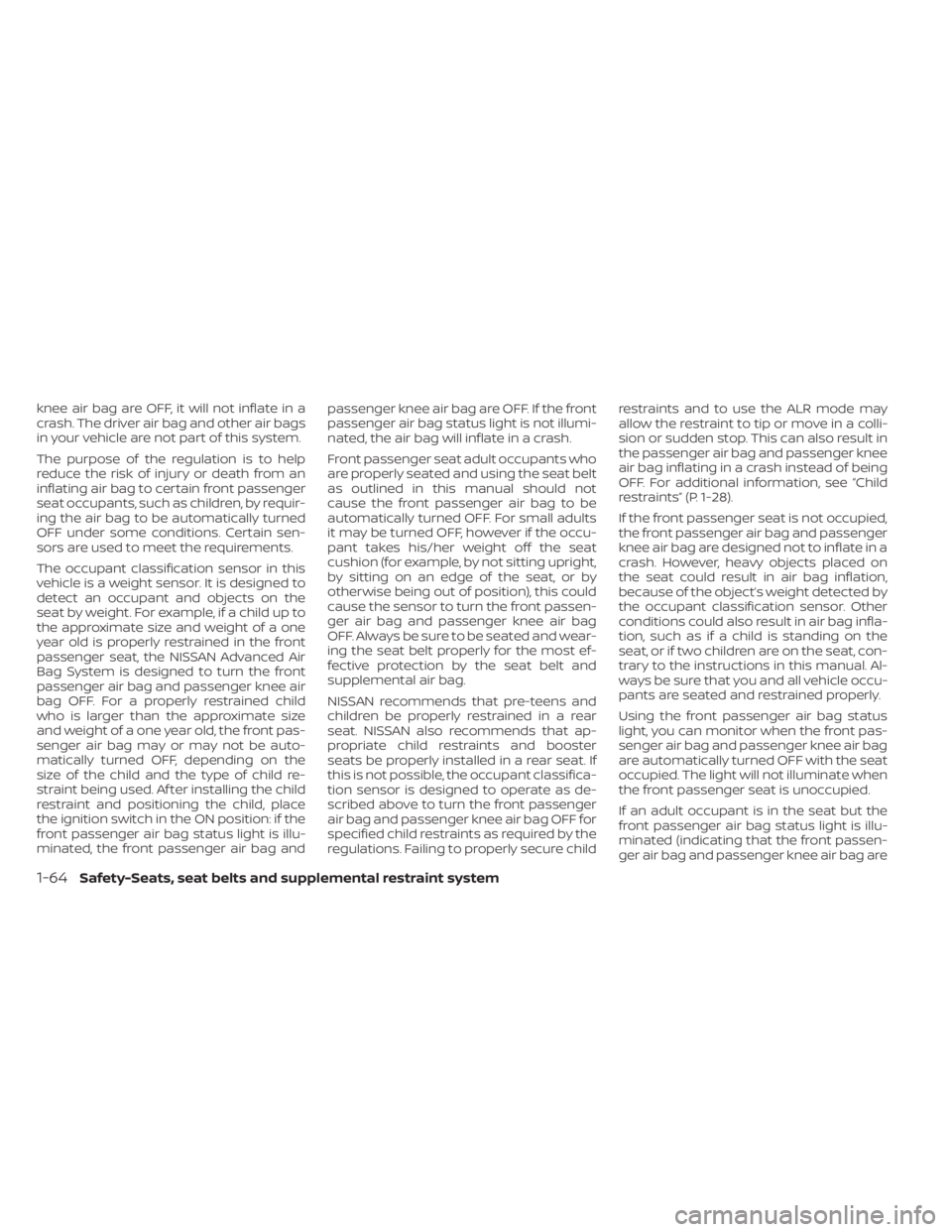
knee air bag are OFF, it will not inflate in a
crash. The driver air bag and other air bags
in your vehicle are not part of this system.
The purpose of the regulation is to help
reduce the risk of injury or death from an
inflating air bag to certain front passenger
seat occupants, such as children, by requir-
ing the air bag to be automatically turned
OFF under some conditions. Certain sen-
sors are used to meet the requirements.
The occupant classification sensor in this
vehicle is a weight sensor. It is designed to
detect an occupant and objects on the
seat by weight. For example, if a child up to
the approximate size and weight of a one
year old is properly restrained in the front
passenger seat, the NISSAN Advanced Air
Bag System is designed to turn the front
passenger air bag and passenger knee air
bag OFF. For a properly restrained child
who is larger than the approximate size
and weight of a one year old, the front pas-
senger air bag may or may not be auto-
matically turned OFF, depending on the
size of the child and the type of child re-
straint being used. Af ter installing the child
restraint and positioning the child, place
the ignition switch in the ON position: if the
front passenger air bag status light is illu-
minated, the front passenger air bag andpassenger knee air bag are OFF. If the front
passenger air bag status light is not illumi-
nated, the air bag will inflate in a crash.
Front passenger seat adult occupants who
are properly seated and using the seat belt
as outlined in this manual should not
cause the front passenger air bag to be
automatically turned OFF. For small adults
it may be turned OFF, however if the occu-
pant takes his/her weight off the seat
cushion (for example, by not sitting upright,
by sitting on an edge of the seat, or by
otherwise being out of position), this could
cause the sensor to turn the front passen-
ger air bag and passenger knee air bag
OFF. Always be sure to be seated and wear-
ing the seat belt properly for the most ef-
fective protection by the seat belt and
supplemental air bag.
NISSAN recommends that pre-teens and
children be properly restrained in a rear
seat. NISSAN also recommends that ap-
propriate child restraints and booster
seats be properly installed in a rear seat. If
this is not possible, the occupant classifica-
tion sensor is designed to operate as de-
scribed above to turn the front passenger
air bag and passenger knee air bag OFF for
specified child restraints as required by the
regulations. Failing to properly secure childrestraints and to use the ALR mode may
allow the restraint to tip or move in a colli-
sion or sudden stop. This can also result in
the passenger air bag and passenger knee
air bag inflating in a crash instead of being
OFF. For additional information, see “Child
restraints” (P. 1-28).
If the front passenger seat is not occupied,
the front passenger air bag and passenger
knee air bag are designed not to inflate in a
crash. However, heavy objects placed on
the seat could result in air bag inflation,
because of the object’s weight detected by
the occupant classification sensor. Other
conditions could also result in air bag infla-
tion, such as if a child is standing on the
seat, or if two children are on the seat, con-
trary to the instructions in this manual. Al-
ways be sure that you and all vehicle occu-
pants are seated and restrained properly.
Using the front passenger air bag status
light, you can monitor when the front pas-
senger air bag and passenger knee air bag
are automatically turned OFF with the seat
occupied. The light will not illuminate when
the front passenger seat is unoccupied.
If an adult occupant is in the seat but the
front passenger air bag status light is illu-
minated (indicating that the front passen-
ger air bag and passenger knee air bag are
1-64Safety-Seats, seat belts and supplemental restraint system
Page 87 of 638
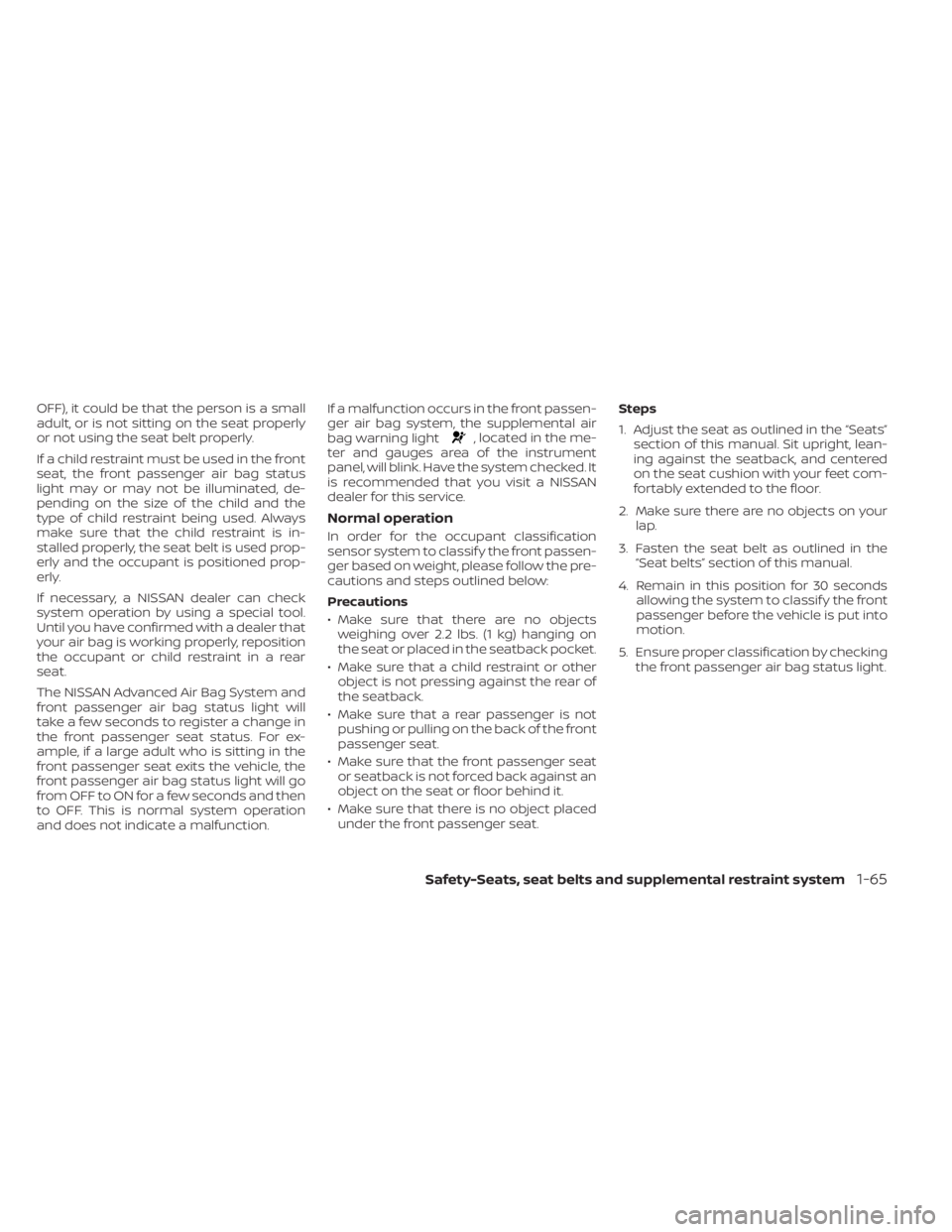
OFF), it could be that the person is a small
adult, or is not sitting on the seat properly
or not using the seat belt properly.
If a child restraint must be used in the front
seat, the front passenger air bag status
light may or may not be illuminated, de-
pending on the size of the child and the
type of child restraint being used. Always
make sure that the child restraint is in-
stalled properly, the seat belt is used prop-
erly and the occupant is positioned prop-
erly.
If necessary, a NISSAN dealer can check
system operation by using a special tool.
Until you have confirmed with a dealer that
your air bag is working properly, reposition
the occupant or child restraint in a rear
seat.
The NISSAN Advanced Air Bag System and
front passenger air bag status light will
take a few seconds to register a change in
the front passenger seat status. For ex-
ample, if a large adult who is sitting in the
front passenger seat exits the vehicle, the
front passenger air bag status light will go
from OFF to ON for a few seconds and then
to OFF. This is normal system operation
and does not indicate a malfunction.If a malfunction occurs in the front passen-
ger air bag system, the supplemental air
bag warning light
, located in the me-
ter and gauges area of the instrument
panel, will blink. Have the system checked. It
is recommended that you visit a NISSAN
dealer for this service.
Normal operation
In order for the occupant classification
sensor system to classif y the front passen-
ger based on weight, please follow the pre-
cautions and steps outlined below:
Precautions
• Make sure that there are no objects weighing over 2.2 lbs. (1 kg) hanging on
the seat or placed in the seatback pocket.
• Make sure that a child restraint or other object is not pressing against the rear of
the seatback.
• Make sure that a rear passenger is not pushing or pulling on the back of the front
passenger seat.
• Make sure that the front passenger seat or seatback is not forced back against an
object on the seat or floor behind it.
• Make sure that there is no object placed under the front passenger seat. Steps
1. Adjust the seat as outlined in the “Seats”
section of this manual. Sit upright, lean-
ing against the seatback, and centered
on the seat cushion with your feet com-
fortably extended to the floor.
2. Make sure there are no objects on your lap.
3. Fasten the seat belt as outlined in the “Seat belts” section of this manual.
4. Remain in this position for 30 seconds allowing the system to classif y the front
passenger before the vehicle is put into
motion.
5. Ensure proper classification by checking the front passenger air bag status light.
Safety-Seats, seat belts and supplemental restraint system1-65
Page 88 of 638
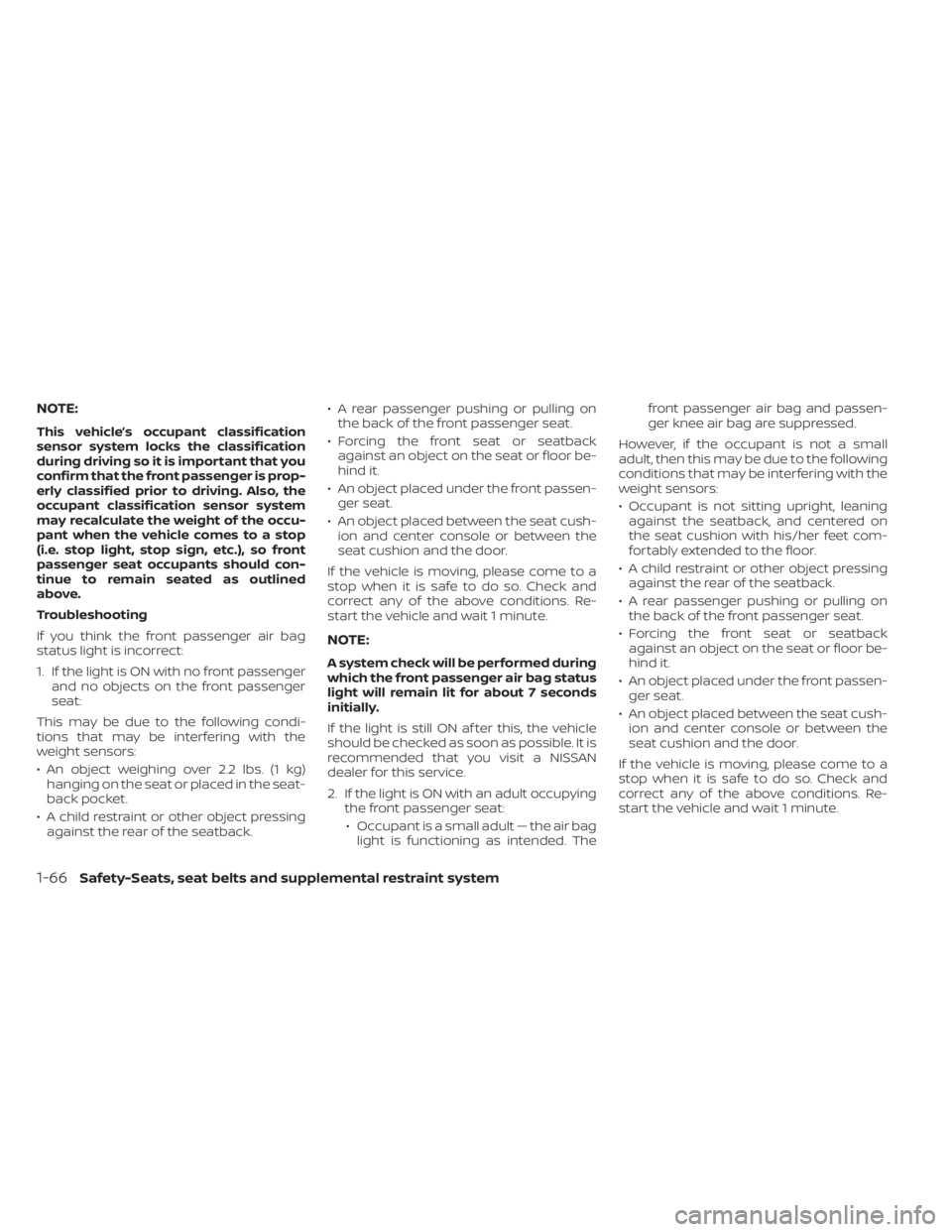
NOTE:
This vehicle’s occupant classification
sensor system locks the classification
during driving so it is important that you
confirm that the front passenger is prop-
erly classified prior to driving. Also, the
occupant classification sensor system
may recalculate the weight of the occu-
pant when the vehicle comes to a stop
(i.e. stop light, stop sign, etc.), so front
passenger seat occupants should con-
tinue to remain seated as outlined
above.
Troubleshooting
If you think the front passenger air bag
status light is incorrect:
1. If the light is ON with no front passengerand no objects on the front passenger
seat:
This may be due to the following condi-
tions that may be interfering with the
weight sensors:
• An object weighing over 2.2 lbs. (1 kg) hanging on the seat or placed in the seat-
back pocket.
• A child restraint or other object pressing against the rear of the seatback. • A rear passenger pushing or pulling on
the back of the front passenger seat.
• Forcing the front seat or seatback against an object on the seat or floor be-
hind it.
• An object placed under the front passen- ger seat.
• An object placed between the seat cush- ion and center console or between the
seat cushion and the door.
If the vehicle is moving, please come to a
stop when it is safe to do so. Check and
correct any of the above conditions. Re-
start the vehicle and wait 1 minute.
NOTE:
A system check will be performed during
which the front passenger air bag status
light will remain lit for about 7 seconds
initially.
If the light is still ON af ter this, the vehicle
should be checked as soon as possible. It is
recommended that you visit a NISSAN
dealer for this service.
2. If the light is ON with an adult occupying the front passenger seat:
• Occupant is a small adult — the air bag light is functioning as intended. The front passenger air bag and passen-
ger knee air bag are suppressed.
However, if the occupant is not a small
adult, then this may be due to the following
conditions that may be interfering with the
weight sensors:
• Occupant is not sitting upright, leaning against the seatback, and centered on
the seat cushion with his/her feet com-
fortably extended to the floor.
• A child restraint or other object pressing against the rear of the seatback.
• A rear passenger pushing or pulling on the back of the front passenger seat.
• Forcing the front seat or seatback against an object on the seat or floor be-
hind it.
• An object placed under the front passen- ger seat.
• An object placed between the seat cush- ion and center console or between the
seat cushion and the door.
If the vehicle is moving, please come to a
stop when it is safe to do so. Check and
correct any of the above conditions. Re-
start the vehicle and wait 1 minute.
1-66Safety-Seats, seat belts and supplemental restraint system